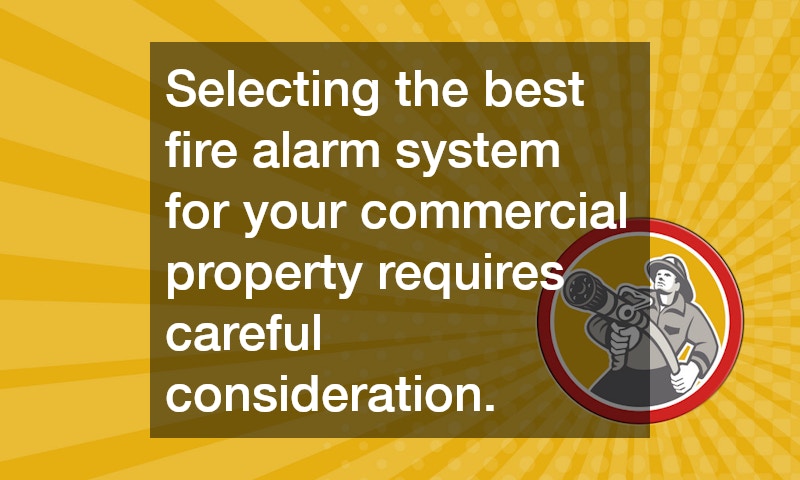Fire safety is a vital concern for any commercial property owner. Protecting employees, customers, and valuable assets requires careful planning and the right equipment. Among these, a reliable fire alarm system plays a critical role in detecting and alerting occupants to danger early. However, with numerous options available, selecting the best solution can feel overwhelming. This guide will help you understand what factors to consider to make the best choice for your property’s safety needs.
Assess Your Commercial Property’s Specific Needs
The first step is to evaluate the unique characteristics of your building. The size, layout, and usage of the space influence the type of fire detection technology required. For instance, a small office may need a straightforward smoke detection setup, while a large warehouse or industrial facility will require more advanced coverage that integrates with other safety features. Older buildings or those with complex floor plans might also need additional devices to ensure full protection.
Understanding the daily activities and potential fire risks associated with your specific business is essential. Consulting with fire safety professionals can clarify requirements and help design a system that complies with safety codes while addressing your unique situation.
Understand Different Types of Fire Detection Technology
Fire detection technology varies greatly in sophistication and capability. Basic systems provide coverage by dividing spaces into zones and triggering alarms when smoke or heat is detected in a given area. More advanced systems can identify the exact location of a potential fire, which speeds response times and reduces confusion during emergencies.
Wireless options offer flexibility for buildings where traditional wiring is impractical, though they require attention to signal reliability. Additionally, integrated systems that combine fire detection with sprinklers, emergency lighting, and communication features can provide comprehensive protection and ease of management.
By understanding these differences, you can better match your commercial property’s needs to the appropriate technology.
Ensure Compliance With Fire Safety Regulations
Every commercial property must adhere to fire safety regulations mandated by local authorities. These regulations are designed to minimize risk and protect occupants. Choosing a system that meets or exceeds these codes is essential not only for legal compliance but also for maintaining insurance coverage.
Noncompliance can lead to fines and liability issues, especially if a fire incident occurs. Working with licensed fire safety consultants or installers ensures that the system you select will satisfy all applicable regulations and pass necessary inspections.
Prioritize Reliability and Maintenance
A fire alarm system must operate flawlessly when needed most. Choosing a system known for durability and backed by reputable manufacturers helps reduce the risk of failure or false alarms. Professional installation and regular testing are critical components to maintaining system reliability.
Maintenance plans should include periodic inspections and updates. Some modern systems offer remote monitoring capabilities, alerting property managers to issues promptly. Consistent upkeep guarantees the system remains fully functional and responsive to any emergency.
Consider Integration Options
Integrating fire detection with other building safety and security systems enhances overall protection. Systems that work seamlessly with access controls, surveillance cameras, and emergency communication tools streamline response efforts during incidents. This interconnected approach not only improves safety but also simplifies monitoring and management for facility staff, providing peace of mind. Integration allows quicker identification of threats and coordinated responses, minimizing damage and potential harm. When evaluating options, consider future scalability to accommodate upgrades or expansions, ensuring long-term effectiveness.
For example, automatically unlocking exit doors when an alarm sounds can facilitate faster evacuation. Visual monitoring tied to alarms helps emergency personnel assess situations quickly and accurately. When selecting your system, consider how well it can connect with your existing safety infrastructure. The ability to centralize control and receive real-time updates significantly enhances emergency response capabilities, making your fire safety measures more robust.
Evaluate Budget and Long-Term Value
Cost is always a factor but should not overshadow quality and effectiveness. Upfront expenses for a reliable system and professional installation may be higher but protect your business from potentially devastating losses. When budgeting, consider ongoing maintenance and monitoring costs as part of your investment.
Obtaining multiple quotes and comparing service offerings helps ensure you receive the best value. Prioritize systems that deliver proven performance and easy upkeep to maximize your safety investment.
Promote Fire Safety Awareness
Technology alone cannot prevent fire-related tragedies. Educating employees and occupants about fire prevention and evacuation procedures is crucial. Regular fire drills and clear instructions empower people to respond calmly and efficiently in emergencies.
Some advanced alarm systems feature voice evacuation capabilities, providing real-time guidance during a crisis. This helps ensure everyone knows where to go and what to do, especially in larger or complex facilities.
Selecting the best fire alarm system for your commercial property requires careful consideration of your building’s characteristics, local regulations, and system capabilities. Prioritizing reliability, integration potential, and occupant readiness creates a safer environment for all.
By investing in a well-chosen fire alarm system and supporting it with proper training and maintenance, you safeguard your business, employees, and customers. Making informed decisions now helps prevent devastating losses and ensures compliance with essential safety standards.


